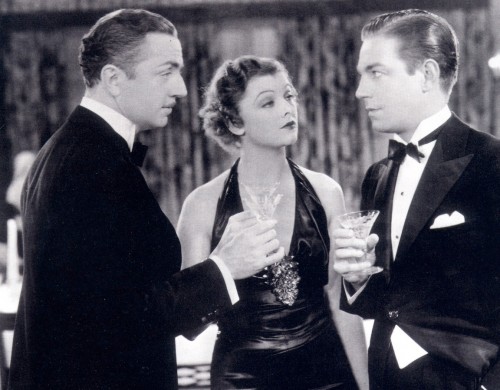 In preparation for New Year’s Eve, everyone needs to know at least a little something about champagne. Long time readers may recognize some of this information, but since many of you are new to Quintessence this year, I am offering an updated version of this must-read guide before the holiday weekend!! Thanks to Wednesday Wine compatriot Terry Rogers of Horseneck Wines in Greenwich for the incredibly informative and insightful take on the history and making of our favorite festive drink!
In preparation for New Year’s Eve, everyone needs to know at least a little something about champagne. Long time readers may recognize some of this information, but since many of you are new to Quintessence this year, I am offering an updated version of this must-read guide before the holiday weekend!! Thanks to Wednesday Wine compatriot Terry Rogers of Horseneck Wines in Greenwich for the incredibly informative and insightful take on the history and making of our favorite festive drink!
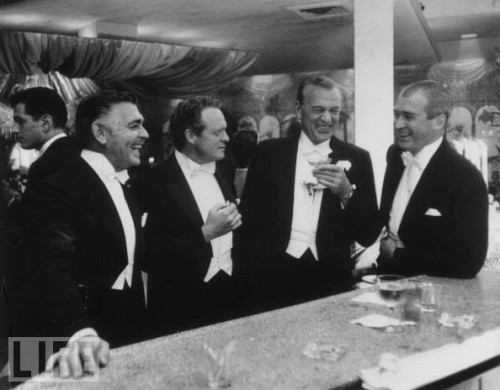 What better way to enjoy the holidays than to get together to share a glass of the good bubbly with friends and family. As you may know, in order to be called Champagne the product must be produced within the boundaries of the Champagne Region in France. This Region was delineated many generations ago and must be adhered to with strict regulations. Therefore, when you look at the prices of Champagne and wonder why they are so high, you must realize all the many factors that go into the making of that final bottle. (from Q – At the end of the history and making of champagne, we have some choice suggestions for you).
What better way to enjoy the holidays than to get together to share a glass of the good bubbly with friends and family. As you may know, in order to be called Champagne the product must be produced within the boundaries of the Champagne Region in France. This Region was delineated many generations ago and must be adhered to with strict regulations. Therefore, when you look at the prices of Champagne and wonder why they are so high, you must realize all the many factors that go into the making of that final bottle. (from Q – At the end of the history and making of champagne, we have some choice suggestions for you).
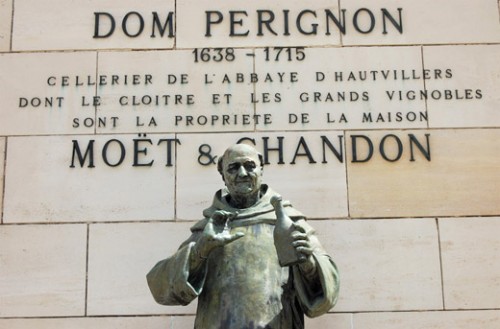 Champagne was developed in France about 300 years ago from a process involving lots of chemistry and many tedious physical manipulations. The history of Champagne dates to about 1700 AD and a monk cellarmaster at the Abbey of Hautvillers near the city of Reims, the “capital” of the Champagne region. As the story goes, a monk named Dom Pérignon was making wine for his colleagues when, unbeknownst to him, he failed to complete the fermentation before bottling and corking the wine. During the cold winter months the fermentation remained dormant, but when spring arrived the contents of the sealed bottles began to warm and fermentation resumed producing carbon dioxide that was trapped in the bottle. Later that spring Dom noticed that bottles of wine in the cellar were exploding, so he opened one that was intact and drank, declaring “Come quickly! I’m drinking stars!” Thus, Champagne was born and named after the region where it was discovered.
Champagne was developed in France about 300 years ago from a process involving lots of chemistry and many tedious physical manipulations. The history of Champagne dates to about 1700 AD and a monk cellarmaster at the Abbey of Hautvillers near the city of Reims, the “capital” of the Champagne region. As the story goes, a monk named Dom Pérignon was making wine for his colleagues when, unbeknownst to him, he failed to complete the fermentation before bottling and corking the wine. During the cold winter months the fermentation remained dormant, but when spring arrived the contents of the sealed bottles began to warm and fermentation resumed producing carbon dioxide that was trapped in the bottle. Later that spring Dom noticed that bottles of wine in the cellar were exploding, so he opened one that was intact and drank, declaring “Come quickly! I’m drinking stars!” Thus, Champagne was born and named after the region where it was discovered.
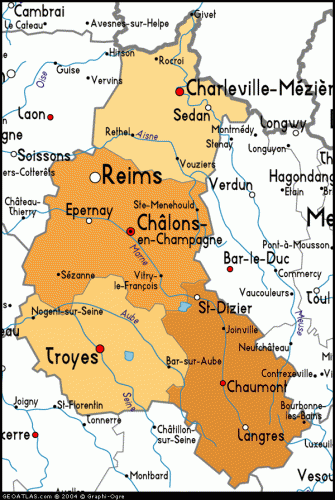 The key reaction of winemaking is alcoholic fermentation, the conversion of sugar into alcohol and carbon dioxide by yeast. The key process in producing Champagne is a SECOND fermentation that occurs in a sealed bottle. The entire process is described below.
The key reaction of winemaking is alcoholic fermentation, the conversion of sugar into alcohol and carbon dioxide by yeast. The key process in producing Champagne is a SECOND fermentation that occurs in a sealed bottle. The entire process is described below.
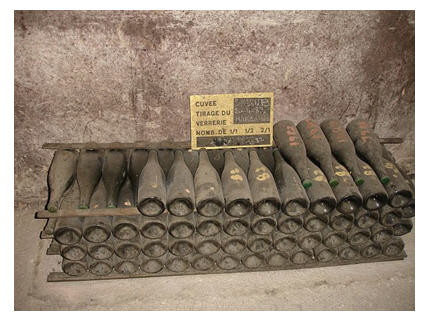 SELECTING THE CUVÉE (La Cuvée)
SELECTING THE CUVÉE (La Cuvée)
The cuvée is the base wine selected to make the Champagne. The most expensive Champagnes are made from cuvées from selected vineyards in the Champagne region. Cuvées can be from a pure grape variety, such as Chardonnay or Pinot Noir, or can be a mixture of several grape varieties. Chardonnay is a white grape variety with white juice, Pinot Noir a red grape variety with WHITE juice. Pinot Meunier, a relative of Pinot Noir, also is used extensively. The slight rust color imparted to some Champagne results from using Pinot Noir cuvées that acquire some red color from contact with the skins. The longer the juice remains in contact with the skins, the darker red it becomes. If a Champagne is made exclusively from Chardonnay, it is called “blanc de blanc,” white wine from white grapes. Most Champagne is made from mixed cuvees.
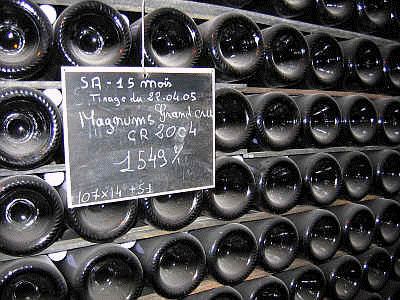 THE TIRAGE
THE TIRAGE
After the cuvée is selected, sugar, yeast, and yeast nutrients are added and the entire concoction, called the tirage, is put in a thick walled glass bottle and sealed with a bottle cap. The tirage is placed in a cool cellar (55-60°F), and allowed to slowly ferment, producing alcohol and carbon dioxide. Since the bottle is sealed, the carbon dioxide cannot escape, and,thereby producing the sparkle of Champagne.
AGING ON DEAD YEAST
As the fermentation proceeds, yeast cells die and after several months, the fermentation is complete. However, the Champagne continues to age in the cool cellar for several more years resulting in a toasty, yeasty characteristic. During this aging period, the yeast cells split open and literally spill their guts into the solution imparting complex, yeasty flavors to the Champagne. The best and most expensive Champagne is aged for five or more years.
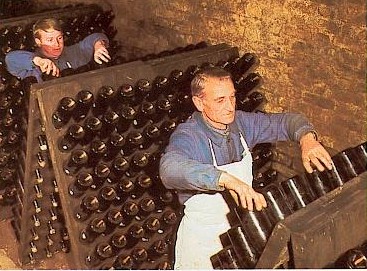 RIDDLING (Le Remuage)
RIDDLING (Le Remuage)
After the aging process is complete, the dead yeast cells are removed through a process known as riddling. The Champagne bottle is placed upside down in a holder at a 75° angle. Each day the riddler comes through the cellar and turns the bottle 1/8th of a turn while keeping it upside down. This procedure forces the dead yeast cells into the neck of the bottle where they are subsequently removed. A riddler typically handles 20,000 to 30,000 bottles per day.
DISGORGING
The Champagne bottle is kept upside down while the neck is frozen in an ice-salt bath. This procedure results in the formation of a plug of frozen wine containing the dead yeast cells. The bottle cap is then removed and the pressure of the carbon dioxide gas in the bottle forces the plug of frozen wine out leaving behind clear Champagne. At this point the DOSAGE, a mixture of white wine, brandy, and sugar, is added to adjust the sweetness level of the wine and to top up the bottle. The bottle is then corked and the cork wired down to secure the high internal pressure of the carbon dioxide.The sweetness levels of Champagne range very dry (ultra brut) to very sweet (doux), with brut being the most common.
 Many Champagne houses produce “luxury cuvées,” their best and most expensive wines. Dom Pérignon is the luxury cuvée of Möet & Chandon; Cristal is the pride of Roederer. Bollinger produces R.D. or “recently disgorged” wines. For example, you can purchase a 1982 Bollinger R.D. that was disgorged in April 1991, nine years after being placed in the bottle. (from Q – this was the champagne we served at our wedding!!)
Many Champagne houses produce “luxury cuvées,” their best and most expensive wines. Dom Pérignon is the luxury cuvée of Möet & Chandon; Cristal is the pride of Roederer. Bollinger produces R.D. or “recently disgorged” wines. For example, you can purchase a 1982 Bollinger R.D. that was disgorged in April 1991, nine years after being placed in the bottle. (from Q – this was the champagne we served at our wedding!!)
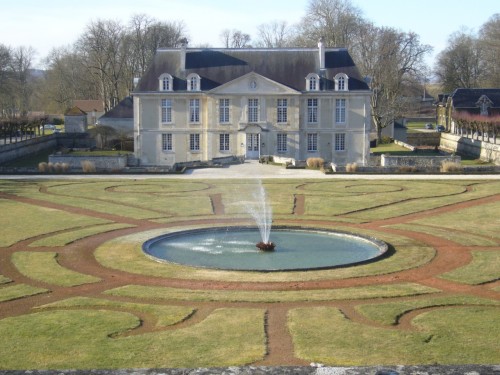
Terry travels to Champagne almost every fall to see the harvest and renew her spirit with “the greatest beverage known to mankind.” Please visit last year’s Champagne 101 post if you would like to take a vicarious trip to four of her favorite Champagne houses: Krug, Billecart-Salmon, Laurent Perrier and Salon.
Although not on Terry’s tour last year, I wanted to add a little something in this year’s round up on one of my favorite champagnes, Ruinart.
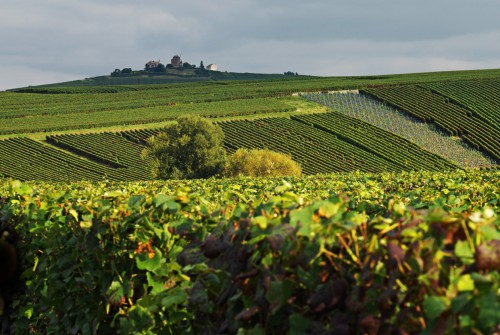 Terry is also a Ruinart fan and suggested, “Whether you have a palate for rosé champagne or the blanc de blanc you will certainly want Ruinart in your future. This champagne is bright, refreshing and full of beautiful pinot noir and chardonnay flavors.”
Terry is also a Ruinart fan and suggested, “Whether you have a palate for rosé champagne or the blanc de blanc you will certainly want Ruinart in your future. This champagne is bright, refreshing and full of beautiful pinot noir and chardonnay flavors.”
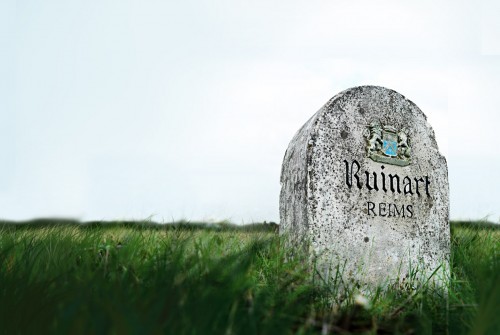 Ruinart is the oldest established Champagne house, exclusively producing champagne since 1729. Founded by Nicolas Ruinart in the Champagne region in the city of Reims, the house is today owned by the parent company LVMH Moët Hennessy Louis Vuitton SA.
Ruinart is the oldest established Champagne house, exclusively producing champagne since 1729. Founded by Nicolas Ruinart in the Champagne region in the city of Reims, the house is today owned by the parent company LVMH Moët Hennessy Louis Vuitton SA. 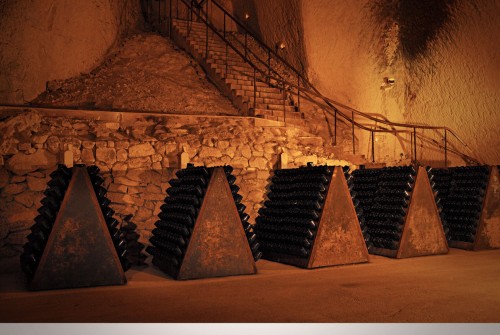 The firm’s famous cellars, a series of Gallo Roman chalk quarries, or crayères, above, are officially classified as a historical monument and can be toured by appointment.
The firm’s famous cellars, a series of Gallo Roman chalk quarries, or crayères, above, are officially classified as a historical monument and can be toured by appointment.
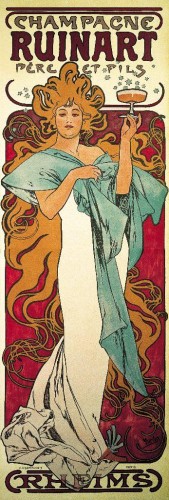 Not only does Ruinart produce a consistently excellent product in relatively small quantities, but it has also had a long standing relationship with the Arts. As early as 1895, Andre Ruinart asked Czech artist, Alfons Mucha to illustrate a poster of Ruinart, above. Today the brand is still closely involved with contemporary art and plays an important role in several international events such as ARCO, the Foire de Bale, the Carre Rive Gauche, London Design, and Miami Art Basel. I love the Ruinart Portraits that artist Gideon Rubin did for Art Basel last June.
Not only does Ruinart produce a consistently excellent product in relatively small quantities, but it has also had a long standing relationship with the Arts. As early as 1895, Andre Ruinart asked Czech artist, Alfons Mucha to illustrate a poster of Ruinart, above. Today the brand is still closely involved with contemporary art and plays an important role in several international events such as ARCO, the Foire de Bale, the Carre Rive Gauche, London Design, and Miami Art Basel. I love the Ruinart Portraits that artist Gideon Rubin did for Art Basel last June.
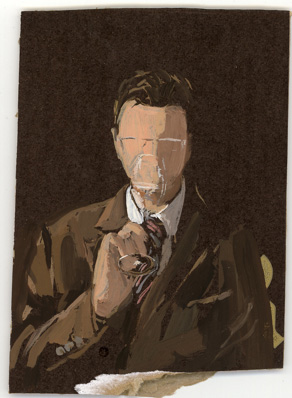
They represent all aspects of Ruinart, from founding fathers to contemporary cellar masters. In addition, the house works with many artists for specialty projects – India Mahdavi, created the “Champagne Spoon” bottle stopper in 2006, Christian Biecher, created the “Flower” bottle stopper in 2007, Patricia Urqiola, designed the “Fil d’Or” bottle stopper in 2010, below,
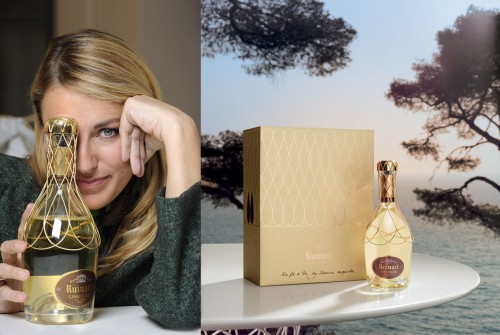 and Maarten Baas, named “Designer of the Year” at Art Basel Miami 2009, created the “Bouquet de Champagne” in 2008 and the “Melting” ice bucket in 2010.
and Maarten Baas, named “Designer of the Year” at Art Basel Miami 2009, created the “Bouquet de Champagne” in 2008 and the “Melting” ice bucket in 2010.
Terry’s Champagne Picks
So starting with Ruinart, here are a few of Terry’s suggestions, for celebrating your New Year in style (and fyi – she can ship anywhere)!
Ruinart blanc de blancs (non vintage), the flagship of their house, $68
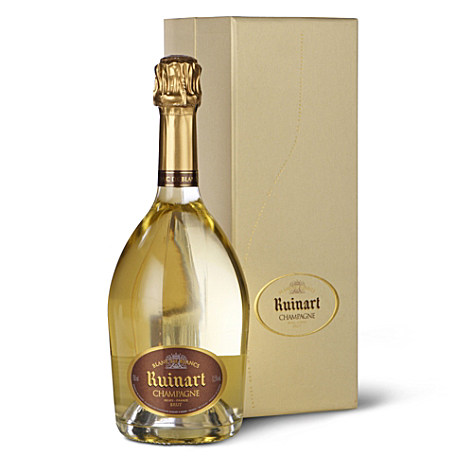
Ruinart Rosé (non vintage) $68
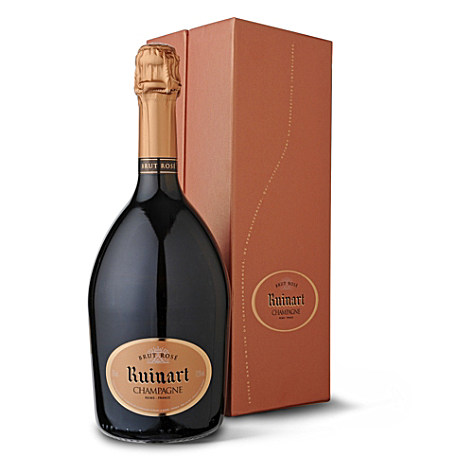 Laurent-Perrier Brut non vintage $36
Laurent-Perrier Brut non vintage $36
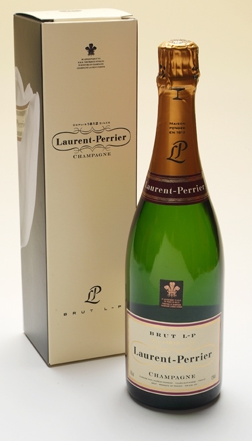
Laurent Perrier Rosé $73
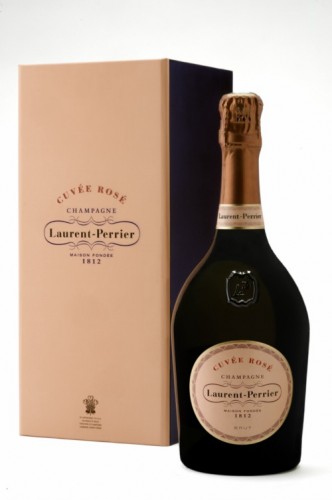 Taittinger Brut non vintage $38
Taittinger Brut non vintage $38
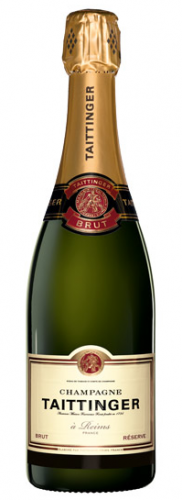
Veuve Clicquote brut non vintage $43
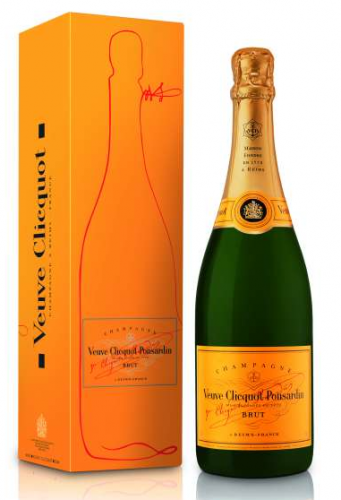
Veuve Clicquot La Grand Dame 1998 $149 (fyi – this was a #Jingletweet prize)
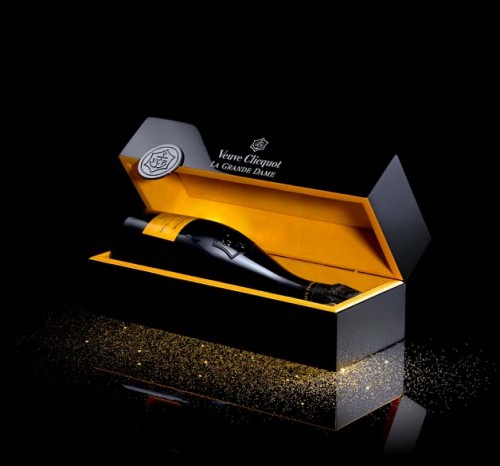
Louis Roederer brut premier non vintage $38
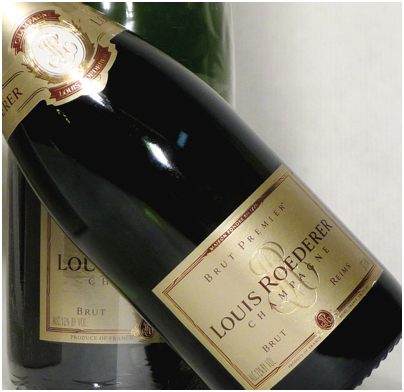
Louis Roederer Cristal 2004 $215
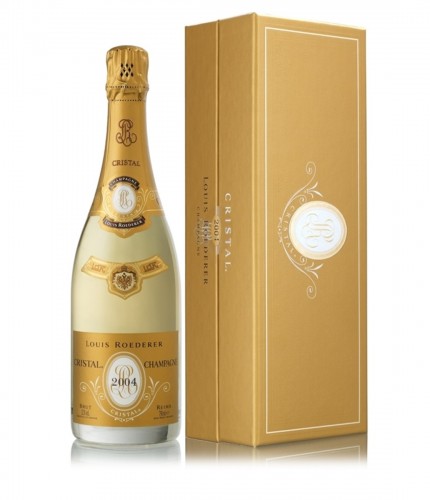 Billecart-Salmon Brut Rosé (non vintage) $74.95
Billecart-Salmon Brut Rosé (non vintage) $74.95
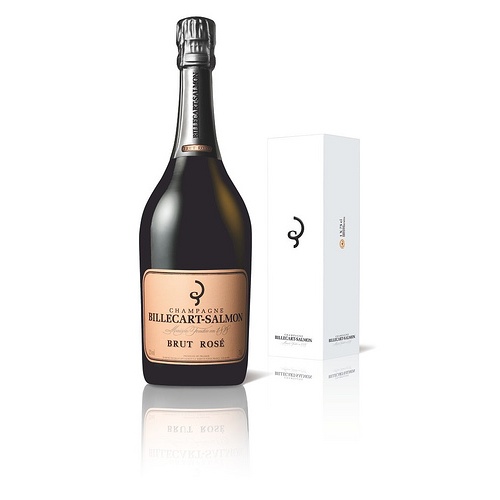
Billecart-Salmon Cuvée Elisabeth Salmon Rose 1999 $175
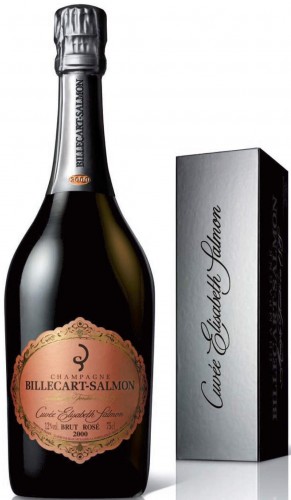
Dom Perignon 2002 $159
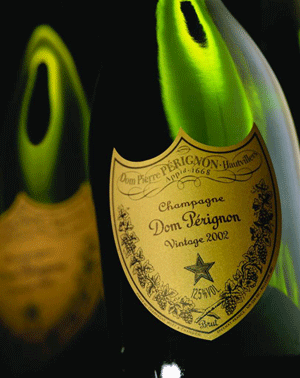 Krug Grand Cuvee is a blend of their various vintages and is a stellar Champagne at $185 per bottle. The Krug wines commonly display a subtle nuttiness. Krug uses complete barrel fermentation which is not so common in most of the champagne houses.
Krug Grand Cuvee is a blend of their various vintages and is a stellar Champagne at $185 per bottle. The Krug wines commonly display a subtle nuttiness. Krug uses complete barrel fermentation which is not so common in most of the champagne houses.
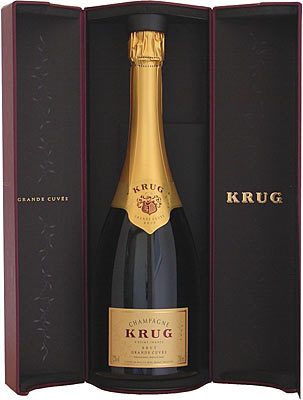
Krug Rosé Brut NV $349
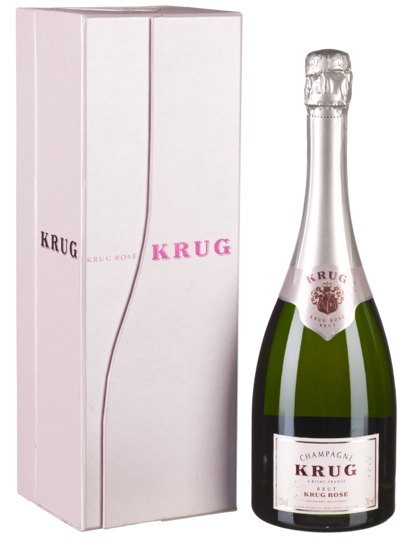
Salon Blanc de Blanc Brut Les Mesnil 1999 $325
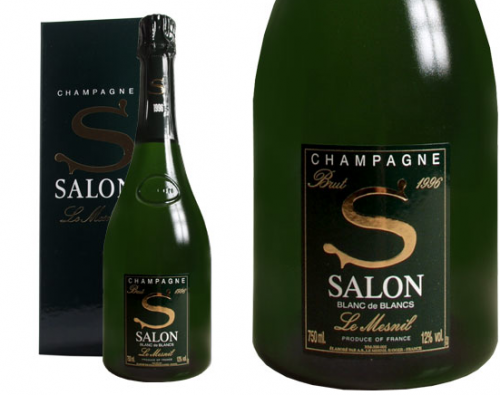
So – plenty to choose from!! Cheers!

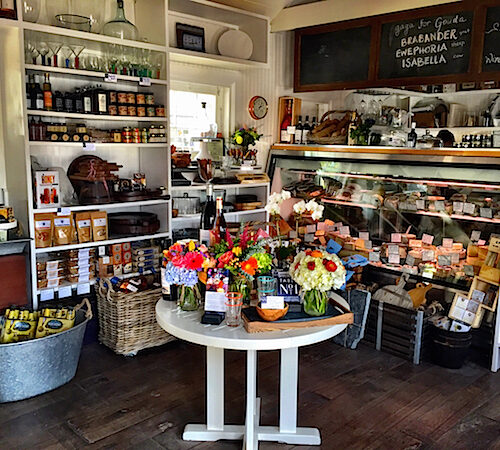




Bring me a bottle of Veuve any day… and really, why does one need a special occasion to open a bottle of bubbly? I say enjoy it whenever you like!
Thank you for this post, while I am familiar with the methode champagnoise (sp?!) I was unaware of many of these fine makers!
Me too – Champagne everyday keeps you bubbly and happy!!
so informative and interesting! Will be wowing friends & fam with our champagne knowledge this New Years Eve!
This is right up my alley, Stacey! I could forego all other forms of spirits and settle on my glass(es) of champagne. Just love everything about a good bottle.
Have a Happy New Year. It has been a pleasure getting to know you in 2011. Looking forward to 2012.
Teresa
xoxo
Always such good info here! Now I have some interesting tidbits to share on New Years Eve. Thanks for the recommendations of the best bubbly!
Ahh, Champagne –– my poison of choice. LOVE Billecart-Salmon and of course, Veuve Cliquot. I have yet to try the Veuve La Grande Dame.
Life is a celebration, so why not drink bubbly as often as you can?
Thank you for the history lesson and for exposing me to a few Champagne houses I’ve never heard of.
Happy New Year!
–Andrea
Here’s to drinking stars!! Wonderful post Stacey and Terry; Happy New Year!! ox
What a timely and delightful post Stacey.
I just made an executive decision that the MR.
and I need to enjoy a glass of bubbly
more often!
Gosh I think the last time we enjoyed a bottle
of Dom Perignon was years ago when we
received it as a thank you from one of MR’s clients.
Those were definitely the days
of champagne & caviar long before the babies
came along!
At the World Equestrian Games this year in Lexington
Veuve Clicquot was one of the sponsors
and had very swell outdoor lounges set up
out on the bluegrass for the spectators.
You could spot them a mile away
with their white leather & chrome club chairs
and signature orange flags waving the very swells
in their direction!
It was quite nice I will admit however,
the MR. monitored my consumption as
to much fine champagne puts me in the mood
for LOVE.
I should mention….MR’s client….Burt Bacharach.
I should also mention…we stay in for New Years Eve.
Good thing!
I hope your New Year is swell Stacey.
Cheers to you and your fabulous Orange Q!
xo Lisa
What an epic article about Champagne. I just don’t know where we would be today without those ‘monks’. Thankyou! My new drink this year is Calvados from Normandy. I am trying to acquire a taste for it because I loved traveling through the region.
I simply adore Champagne, for so many reasons. I cant resist a posting of such starry delight either. I could drink Champagne every night and there are some amazing and affordable choices. A couple on your list are favorites, although not all are for everyday drinking. :) The best way to celebrate life is to include some bubbles!
Happy New Year!
Jennifer Duchene
You are always a wealth of information and, of course, just in time to ring in the New Year. Wishing you all the best in 2012!!
We opened a 16 year old bottle of Cristal on Christmas Day – oh my it was delicious, I don’t know how to store wine so I had just stuck it in the fridge for years, my main surprise was the intense yellow colour.
Christmas Eve was Laurent Perrier rose and New Year’s day luncheon will be washed down with Veuve – do we have to go back to normal in January?
Stacey,
I knew listing the bloggers’ blogrolls was risky but I had to say thank you! Thank you so much for messaging me & I just added you. Best to you in 2012. Love!
Such a glorious guide to my favorite beverage! Well done, Stacey. I will be raising a glass of “the greatest drink known to mankind” to toast both you and Terry on New Year’s Eve. Wishing you a very Happy New Year and a sparkling 2012! XO
This is such a wonderful post. If only I was feeling up to drinking champagne, but I will have to do a belated celebration because these all sound delicious! Hope you have a wonderful New Year’s Eve Stacey, and have an extra glass for me{!}
Thank you also for your very kind comment today, I so appreciate that. Love the tartan you used for Christmas!
xo Mary Jo
One thing that has surprised me moving around is that most places don’t serve champagne by the glass; I guess that’s just a city thing. Well, I’ll be darned if one should let the rest of the bottle go to waste!